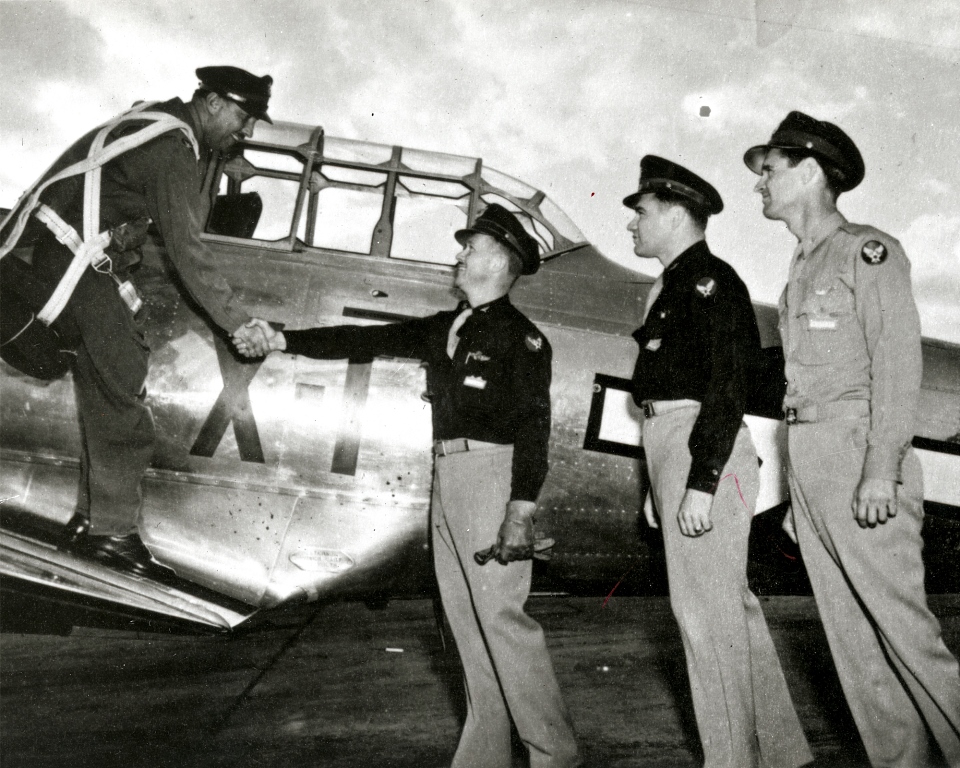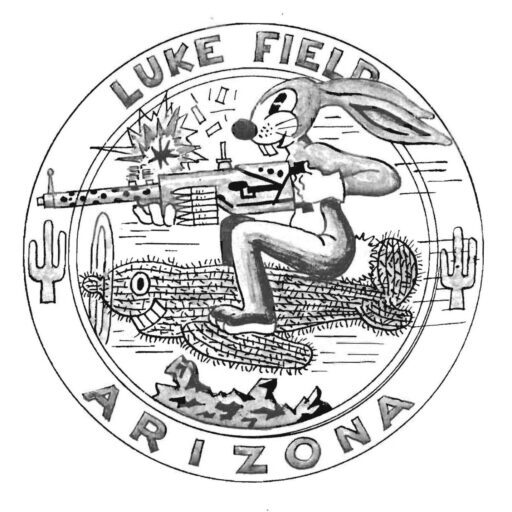To honor the men and women who flew and trained at Luke Field, Arizona, during World War II.
Luke Field History
When we look back in time, we tend to think that our forefathers knew exactly what they were doing and that each step was the logical progression from the previous step. At least in World War II, that was far from the truth for the US Army Air Corps. In 1939, the US Army Air Corps only had 26,500 men and 2,200 aircraft of all types. In six years, it would be 10 times the size in manpower and have almost 30 times as many aircraft. That rapid growth meant they were making a lot of it up as they went to include organizational structures, training, tactics, best flying formations for combat, etc. What became Luke Field went from farm land and desert scrub to the world’s largest pilot training base in an astounding short amount of time.
The history of Luke Field (later, Luke Air Force Base), actually began during the Battle of Britain. With the losses of pilots and aircraft on both sides of that air-to-air campaign, President Franklin D. Roosevelt made a decision. On August 8, 1940, he called for the military to produce 12,000 pilots a year for the US Army Air Corps planned 54-Groups. Roosevelt’s order dramatically increased the number of pilots the Army was to produce. On December 17, 1940, President Roosevelt increased the requirement to 30,000 pilots per year.
Site selection
Therefore, the Army Engineers began to look for locations across the US where they could build temporary training bases. Good flying weather was a major factor in determining where the majority of those bases would be. As a result, the Army selected a number of sites in Arizona. On October 1, 1940, the Army’s airport engineer chief, Lt. Col. Arthur L Wilson, arrived in Phoenix, Arizona, to discuss possible establishment of flying training base in the Salt River Valley. The Phoenix Chamber of Commerce was very interested and took part in the negotiations.
On November 26, 1940, Brig. Gen. Henry W. Harms, West Coast Training Center commander, recommended Phoenix as a site to War Department for construction of advanced single engine flying training base. In February 1941, Lt. Col. Ennis C. Whitehead surveyed the Salt River Valley and chose a site on the far west side of the valley close to the White Tank Mountains. Whitehead’s job was to establish an Advanced Flying Training base. On February 13, 1941, Mr. Donald C. Scott, the City Manager for Phoenix announced that the War Dept okayed for site just north of Litchfield Park, Arizona. Civic leaders bought the 1,440 acres for $40,000 and leased it to the Federal Government for $1 a year. Shortly after, the War Department approved the site.
Construction
On March 24, 1941, the Del E. Webb Construction Company began clearing the land for construction. Five days later, they broke ground for the first building. Del Webb later built Sun City. On March 29, 1941, the Del Webb Company began excavation for the foundations of the first building. Construction ran 24-hours a day. While Del Webb completed the initial construction in about 11 months, construction continued on the base until April 1945, days before the fall of Germany. Initially, priority went to construction that would support flying operations.
With on-going construction, Lt. Col Whitehead could not use the field right away. Therefore, he set up his operations at Thunderbird Field in Glendale, Arizona. At that time, Thunderbird Field was a Primary Flying School. On May 14, 1941, Whitehead moved his headquarters to the National Guard Armory in Phoenix. That move was primarily due to the increase in staff and students coming to work and learn. Students and instructors stayed in hotels in Phoenix. The enlisted men lodged in makeshift housing at the National Guard Armory.
In June 1941, Airmen began to take over buildings at what, on April 21, 1941, became Litchfield Park Army Air Field. As Dell Webb completed a building, Airmen moved in, only to move again when more appropriate facilities were available. On June 1, 1941, a Flight Instructor, 2nd Lt. Martin D. Mulligan, flying his AT-6 Texan made the first landing on the field, six weeks before Del Webb could complete the landing facilities.
On June 6, 1941, Litchfield Park Field was officially renamed Luke Army Air Field, or Luke Field for short. Luke Field in Arizona was actually the second field to carry that name. The first field was located on the co-owned Army-Navy island in Pearl Harbor outside of Honolulu, Territory of Hawaii. When the Army moved its Luke Field air operations to Hickam Field, Territory of Hawaii, in 1939, it asked the Navy for Luke Field name back to use in Arizona. The Navy renamed the island Naval Air Station Ford Island. Click here for information about Frank Luke.
On September 29, 1941, Mrs. Tillie Luke, the mother of Frank Luke, Jr., attended the ceremony that formally dedicated Luke Field.
By December 7, 1941, the Webb Company completed 95% of the facilities to support 3,700 people. That day, the Japanese attacked the military facilities in Pearl Harbor to include Ford Island, at Hickam Field, and Wheeler Field, Territory of Hawaii. After December 7, 1941, the pace of growth at Luke Field increased dramatically.
During World War II, the US Army was segregated. At Luke Field, that meant separate facilities for African-Americans. The segregated barracks were east of Litchfield Road, across from the North Gate, which is about where the Lightning Gate, the Visitors Center, and the Veterinary Service buildings stand today.
Training
Also, on June 6, 1941, 34 enlisted men arrived to set up support functions. That same day, the first class of 45 students arrived for Advanced Flying Training. Until July 15, 1941, the students and instructors flew training missions out of Sky Harbor Airport, a handful of miles southeast of downtown Phoenix. On July 1, 1941, Whitehead moved his operations to Luke Field, even though many buildings including his headquarters building were unfinished. On June 11, 1941, the mess at Luke Field opened. On July 15, 1941, Whitehead permanently moved flight operations to Luke Field. Shortages of just about everything from plates to office equipment caused the Airmen to scrounge all over the Salt River Valley to borrow or obtain those needed items. Those efforts included the tools the mechanics needed to maintain the AT-6.
While Luke Field trained pilots from all over the world, the first and most lasting foreign military to train at Luke Field was the Chinese Air Force. On March 27, 1942, the first Chinese Air Force Advanced Flying Training class, Class 42-E, graduated 42 students. On June 22, 1942, Luke Field began Transition Training in the Curtis P-40 Warhawk. On September 12, 1942, the first Chinese Air Force P-40 class, 42-F, graduated 40 students. It was also the first P-40 class to graduate from Luke Field. On October 2, 1942, Luke field graduated its first Army Air Forces P-40 training class.
During 1942, not everything went smoothly at Luke Field. On July 14, 1942, heavy rains filled the canal near Luke Field, which flooded the base. In September 1942, heavy rains fell again and damaged Luke Field, which disrupted training.
On March 14, 1943, Luke Field revised its P-40 operational training unit into the P-40 fighter transition training program. In April 1943, Luke Field graduated its first US P-40 fighter transition class. On June 5, 1943, the first Women’s Army Auxiliary Corps members arrived at Luke Field. In July 1943, pilots and students flew a record-setting 49,784 sorties during in one month. In 1943, Luke Field produced a record 6,447 graduates during the year.

It only took the instructors and students of Luke Field 34 months to fly 1,000,000 hours. To put that achievement into perspective, it took the F-16s at Luke AFB 30 years to fly 1,0000,000 hours.
In June 1944, Luke Field had 549 aircraft of all types assigned, the vast majority being AT-6 Texans. After D-Day in Europe, training at Luke Field began to shift. Part of that shift was in preparation for the expected long fight to conquer the four main home islands of Japan. In 1945, the P-40s would slowly be replaced by the P-38 Lightning and later still they added the P-51 Mustang. Only a few P-47 Thunderbolts were assigned after Japan surrendered.
On August 23, 1944, the first Women Air Force Service Pilots (WASP) arrived at Luke Field. On December 20, 1944, WASP unit inactivated. The ladies were told they had to find their own way home.
On March 13, 1945, Lockheed P-38 Lightning fighter transition training began. In July 1945, North American P-51 Mustang fighter transition training began.
On August 14, 1945, with Japanese Emperor Hirohito’s announcement over the radio of his country’s surrender, Luke Field immediately terminated all P-40, P-38, and P-51 training for US pilots. On October 13, 1945, Chinese Air Force P-40 training ended. On May 15, 1946, Chinese Air Force P-51 training ended and Class 46-A (AT-6) graduated as last class at Luke Field.
Learning to fly was one thing, but key to tactical flight training were ranges for flight operations, as well as gunnery and bombardment training. On September 5, 1941, President Roosevelt signed Executive Order 8892 which withdraw federal lands at Gila Bend, Arizona, from public use and set land aside for bombing and gunnery practice. On January 30, 1942, the government placed the Gila Bend Gunnery Range in an exempted status. On March 18, 1942, President Roosevelt issued Executive Order 9104, which again allowed military use of the Gila Bend Range. On November 6, 1942, Interior Department issued Order 56 allowing the military to continue to use the Gila Bend Range. On February 28, 1945, Executive Order 9526 allowed the military continued use of Gila Bend Range.
During World War II, Luke Field graduated 17,231 student pilots including 13,568 US and 508 Chinese Air Force pilots in the AT-6, 2,483 US and 331 Chinese Air Force pilots in P-40, 280 US pilots in P-38, and 61 US pilots in P-51 program.
On November 30, 1946, 3028th Army Air Forces Air Base Unit inactivated at Luke Field. The base became an auxiliary field of Williams Field, Arizona. That same day, the government reassigned the Gila Bend Range to Williams Field and redesignated it as the Williams Bombing and Gunnery Range.
